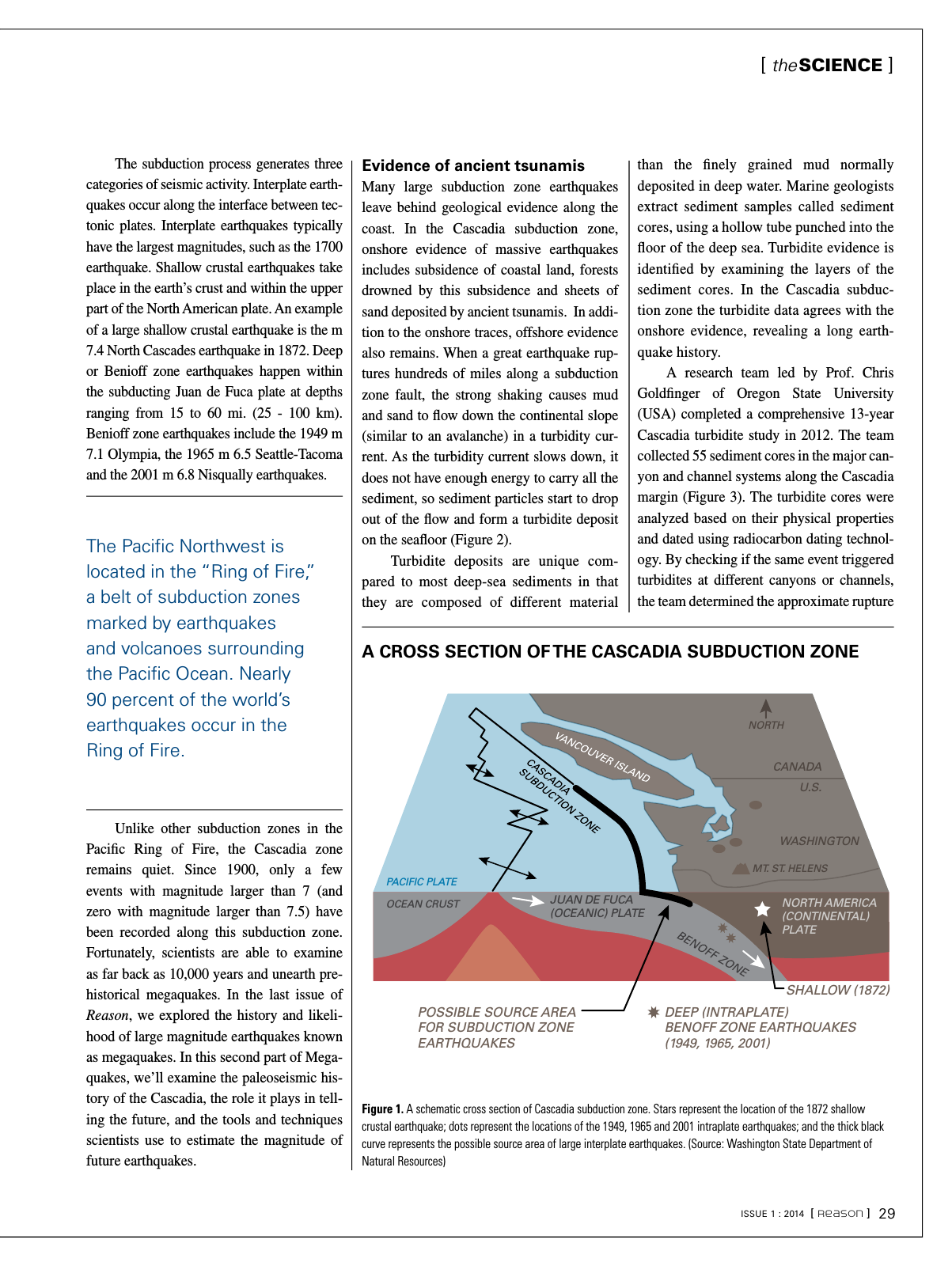Reason Mag Q1 2014 Seite 29
Hinweis: Dies ist eine maschinenlesbare No-Flash Ansicht.Klicken Sie hier um zur Online-Version zu gelangen.
Inhalt
PACIFIC PLATE OCEAN CRUST JUAN DE FUCA OCEANIC PLATE NORTH AMERICA CONTINENTAL PLATE DEEP INTRAPLATE BENOFF ZONE EARTHQUAKES 1949 1965 2001 SHALLOW 1872 POSSIBLE SOURCE AREA FOR SUBDUCTION ZONE EARTHQUAKES CANADA U S WASHINGTON MT ST HELENS NORTH The subduction process generates three categories of seismic activity Interplate earth quakes occur along the interface between tec tonic plates Interplate earthquakes typically have the largest magnitudes such as the 1700 earthquake Shallow crustal earthquakes take place in the earth s crust and within the upper part of the North American plate An example of a large shallow crustal earthquake is the m 7 4 North Cascades earthquake in 1872 Deep or Benioff zone earthquakes happen within the subducting Juan de Fuca plate at depths ranging from 15 to 60 mi 25 100 km Benioff zone earthquakes include the 1949 m 7 1 Olympia the 1965 m 6 5 Seattle Tacoma and the 2001 m 6 8 Nisqually earthquakes Unlike other subduction zones in the Paci c Ring of Fire the Cascadia zone remains quiet Since 1900 only a few events with magnitude larger than 7 and zero with magnitude larger than 7 5 have been recorded along this subduction zone Fortunately scientists are able to examine as far back as 10 000 years and unearth pre historical megaquakes In the last issue of Reason we explored the history and likeli hood of large magnitude earthquakes known as megaquakes In this second part of Mega quakes we ll examine the paleoseismic his tory of the Cascadia the role it plays in tell ing the future and the tools and techniques scientists use to estimate the magnitude of future earthquakes A CROSS SECTION OF THE CASCADIA SUBDUCTION ZONE Figure 1 A schematic cross section of Cascadia subduction zone Stars represent the location of the 1872 shallow crustal earthquake dots represent the locations of the 1949 1965 and 2001 intraplate earthquakes and the thick black curve represents the possible source area of large interplate earthquakes Source Washington State Department of Natural Resources Evidence of ancient tsunamis Many large subduction zone earthquakes leave behind geological evidence along the coast In the Cascadia subduction zone onshore evidence of massive earthquakes includes subsidence of coastal land forests drowned by this subsidence and sheets of sand deposited by ancient tsunamis In addi tion to the onshore traces offshore evidence also remains When a great earthquake rup tures hundreds of miles along a subduction zone fault the strong shaking causes mud and sand to ow down the continental slope similar to an avalanche in a turbidity cur rent As the turbidity current slows down it does not have enough energy to carry all the sediment so sediment particles start to drop out of the ow and form a turbidite deposit on the sea oor Figure 2 Turbidite deposits are unique com pared to most deep sea sediments in that they are composed of different material than the nely grained mud normally deposited in deep water Marine geologists extract sediment samples called sediment cores using a hollow tube punched into the oor of the deep sea Turbidite evidence is identi ed by examining the layers of the sediment cores In the Cascadia subduc tion zone the turbidite data agrees with the onshore evidence revealing a long earth quake history A research team led by Prof Chris Gold nger of Oregon State University USA completed a comprehensive 13 year Cascadia turbidite study in 2012 The team collected 55 sediment cores in the major can yon and channel systems along the Cascadia margin Figure 3 The turbidite cores were analyzed based on their physical properties and dated using radiocarbon dating technol ogy By checking if the same event triggered turbidites at different canyons or channels the team determined the approximate rupture The Pacific Northwest is located in the Ring of Fire a belt of subduction zones marked by earthquakes and volcanoes surrounding the Pacific Ocean Nearly 90 percent of the world s earthquakes occur in the Ring of Fire ISSUE 1 2014 Reason 29 theSCIENCE
